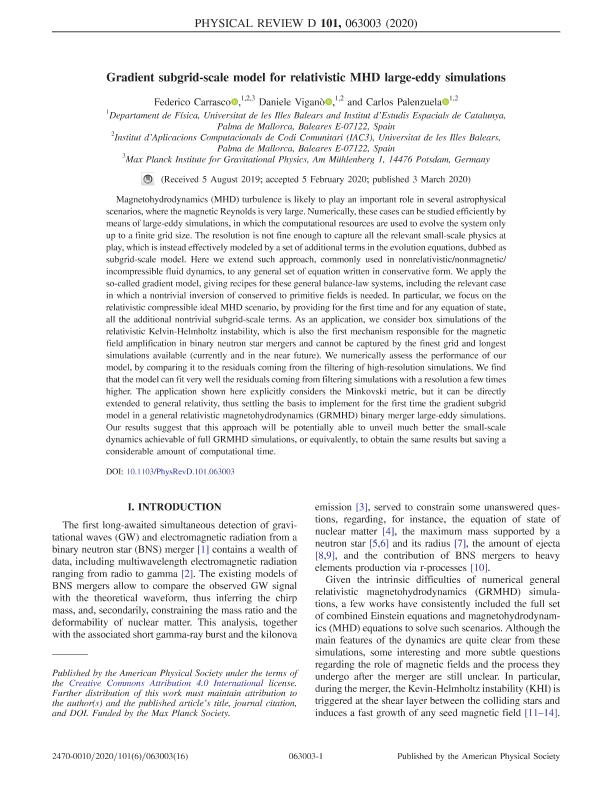Artículo
Gradient subgrid-scale model for relativistic MHD large-eddy simulations
Fecha de publicación:
15/03/2020
Editorial:
American Physical Society
Revista:
Physical Review D
ISSN:
2470-0010
e-ISSN:
2470-0029
Idioma:
Inglés
Tipo de recurso:
Artículo publicado
Clasificación temática:
Resumen
Magnetohydrodynamics (MHD) turbulence is likely to play an important role in several astrophysical scenarios, where the magnetic Reynolds is very large. Numerically, these cases can be studied efficiently by means of large-eddy simulations, in which the computational resources are used to evolve the system only up to a finite grid size. The resolution is not fine enough to capture all the relevant small-scale physics at play, which is instead effectively modeled by a set of additional terms in the evolution equations, dubbed as subgrid-scale model. Here we extend such approach, commonly used in nonrelativistic/nonmagnetic/incompressible fluid dynamics, to any general set of equation written in conservative form. We apply the so-called gradient model, giving recipes for these general balance-law systems, including the relevant case in which a nontrivial inversion of conserved to primitive fields is needed. In particular, we focus on the relativistic compressible ideal MHD scenario, by providing for the first time and for any equation of state, all the additional nontrivial subgrid-scale terms. As an application, we consider box simulations of the relativistic Kelvin-Helmholtz instability, which is also the first mechanism responsible for the magnetic field amplification in binary neutron star mergers and cannot be captured by the finest grid and longest simulations available (currently and in the near future). We numerically assess the performance of our model, by comparing it to the residuals coming from the filtering of high-resolution simulations. We find that the model can fit very well the residuals coming from filtering simulations with a resolution a few times higher. The application shown here explicitly considers the Minkovski metric, but it can be directly extended to general relativity, thus settling the basis to implement for the first time the gradient subgrid model in a general relativistic magnetohydrodynamics (GRMHD) binary merger large-eddy simulations. Our results suggest that this approach will be potentially able to unveil much better the small-scale dynamics achievable of full GRMHD simulations, or equivalently, to obtain the same results but saving a considerable amount of computational time.
Archivos asociados
Licencia
Identificadores
Colecciones
Articulos(IFEG)
Articulos de INST.DE FISICA ENRIQUE GAVIOLA
Articulos de INST.DE FISICA ENRIQUE GAVIOLA
Citación
Carrasco, Federico León; Viganò, Daniele; Palenzuela, Carlos; Gradient subgrid-scale model for relativistic MHD large-eddy simulations; American Physical Society; Physical Review D; 101; 6; 15-3-2020; 1-16
Compartir
Altmétricas




